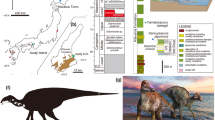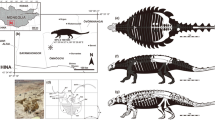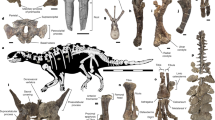Abstract
Ankylosauria is a diverse clade of armoured dinosaurs whose members were important constituents of many Cretaceous faunas. Phylogenetic analyses imply that the clade diverged from its sister taxon, Stegosauria, during the late Early Jurassic, but the fossil records of both clades are sparse until the Late Jurassic (~150 million years ago). Moreover, Ankylosauria is almost entirely restricted to former Laurasian continents, with only a single valid Gondwanan taxon. Spicomellus afer gen. et sp. nov. appears to represent the earliest-known ankylosaur and the first to be named from Africa, from the Middle Jurassic (Bathonian–Callovian) of Morocco, filling an important gap in dinosaur evolution. The specimen consists of a rib with spiked dermal armour fused to its dorsal surface, an unprecedented morphology among extinct and extant vertebrates. The specimen reveals an unrealized morphological diversity of armoured dinosaurs during their early evolution, and implies the presence of an important but undiscovered Gondwanan fossil record.
This is a preview of subscription content, access via your institution
Access options
Access Nature and 54 other Nature Portfolio journals
Get Nature+, our best-value online-access subscription
$29.99 / 30 days
cancel any time
Subscribe to this journal
Receive 12 digital issues and online access to articles
$119.00 per year
only $9.92 per issue
Buy this article
- Purchase on Springer Link
- Instant access to full article PDF
Prices may be subject to local taxes which are calculated during checkout


Similar content being viewed by others
Data availability
All data associated with this paper are included in Extended Data. The specimen described in this study is reposited in the collections of the Natural History Museum, London, under specimen number NHMUK PV R37412. This published work and the nomenclatural acts it contains are registered with ZooBank (LSID: urn:lsid:zoobank.org:act:D12DDAB4-E164-411D-8406-B7B3DEC52F71LSID: urn:lsid:zoobank.org:act:D12DDAB4-E164-411D-8406-B7B3DEC52F71).
References
Vickaryous, M. K., Maryańska, T. & Weishampel, D. B. in The Dinosauria (eds Weishampel, D. B. et al.) 363–392 (Univ. California Press, 2004).
Thompson, R. S., Parish, J. C., Maidment, S. C. R. & Barrett, P. M. Phylogeny of the ankylosaurian dinosaurs. J. Syst. Palaeontol. 10, 301–312 (2012).
Arbour, V. M. & Currie, P. J. Systematics, phylogeny and palaeobiogeography of the ankylosaurid dinosaurs. J. Syst. Palaeontol. 14, 385–444 (2016).
Maidment, S. C. R., Raven, T. J., Ouarhache, D. & Barrett, P. M. North Africa’s first stegosaur: implications for Gondwanan thyreophoran dinosaur diversity. Gondwana Res. 77, 82–97 (2020).
Galton, P. M. Sarcolestes leedsi Lydekker, an ankylosaurian dinosaur from the Middle Jurassic of England. Neues Jahrb. Geol. Palaeontol. Monatsh. 1983, 141–155 (1983).
Leahey, L., Molnar, R. E., Carpenter, K., Witmer, L. M. & Salisbury, S. W. Cranial osteology of the ankylosaurian dinosaur formerly known as Minmi sp. (Ornithischia: Thyreophora) from the Lower Cretaceous Allaru Mudstone of Richmond, Queensland, Australia. PeerJ 3, e1475 (2015).
Owen, R. Report on British fossil reptiles. Rep. Brit. Assoc. Adv. Sci. 11, 60–204 (1842).
Seeley, H. G. On the classification of the fossil animals commonly named Dinosauria. Proc. R. Soc. Lond. 43, 258–265 (1888).
Osborn, H. F. Two Lower Cretaceous dinosaurs of Mongolia. Am. Mus. Novit. 95, 1–10 (1923).
de Buffrénil, V., Farlow, J. O. & de Ricqlès, A. Growth and function of Stegosaurus plates: evidence from bone histology. Paleobiology 12, 459–473 (1986).
Scheyer, T. M. & Sander, P. M. Histology of ankylosaur osteoderms: implications for systematics and function. J. Vertebr. Paleontol. 24, 874–893 (2004).
Scheyer, T. M., Sander, P. M., Joyce, W. G., Bohme, W. & Witzel, U. A plywood structure in the shell of fossil and living soft-shelled turtles (Trionychidae) and its evolutionary implications. Org. Divers. Evol. 7, 136–144 (2007).
Berkovitz, B. & Shellis, R. P. The Teeth of Non-mammalian Vertebrates (Academic Press, 2017).
Schnetz, L., Pfaff, C. & Kriwet, J. Tooth development and histology patterns in lamniform sharks (Elasmobranchii, Lamniformes) revisited. J. Morphol. 277, 1584–1598 (2016).
Jambura, P. L. et al. Micro-computed tomography imaging reveals the development of a unique tooth mineralization pattern in mackerel sharks (Chondrichthyes, Lamniformes) in deep time. Sci. Rep. 9, 9652 (2019).
Jambura, P. L. et al. Evolutionary trajectories of tooth histology patterns in modern sharks (Chondrichthyes, Elasmobranchii). J. Anat. 236, 753–771 (2020).
Reid, R. E. H. Bone histology of the Cleveland-Lloyd dinosaurs and of dinosaurs in general, part 1: introduction to bone tissues. BYU Geol. Stud. 41, 25–72 (1996).
Main, R. P., de Ricqlès, A., Horner, J. R. & Padian, K. The evolution and function of thyreophoran dinosaur scutes: implications for plate function in stegosaurs. Paleobiology 31, 291–314 (2005).
Dubansky, B. H. & Dubansky, B. D. Natural development of dermal ectopic bone in the American alligator (Alligator mississippiensis) resembles heterotopic ossification disorders in humans. Anat. Rec. 301, 56–76 (2018).
Kirby, A. et al. A comparative histological study of the osteoderms in the lizards Heloderma suspectum (Squamata: Helodermatidae) and Varanus komodoensis (Squamata: Varanidae). J. Anat. 236, 1035–1043 (2020).
Shadwick, R. E., Russell, A. P. & Lauff, R. F. The structure and mechanical design of rhinoceros dermal armour. Philos. Trans. R. Soc. Lond. B 337, 419–428 (1992).
Hall, B. K. Bones and Cartilage, Development and Evolutionary Skeletal Biology (Elsevier, 2015).
Galton, P. M. & Upchurch, P. in The Dinosauria (eds Weishampel, D. B. et al.) 343–362 (Univ. California Press, 2004).
Barrett, P. M., Clarke, J. B., Brinkman, D. B., Chapman, S. D. & Ensom, P. C. Morphology, histology and identification of the ‘granicones’ from the Purbeck Limestone Formation (Lower Cretaceous: Berriasian) of Dorset, southern England. Cretac. Res. 23, 279–295 (2002).
Burns, M. E. & Currie, P. J. External and internal structure of ankylosaur (Dinosauria, Ornithischia) osteoderms and their systematic relevance. J. Vertebr. Paleontol. 34, 835–851 (2014).
Norman, D. B. Scelidosaurus harrisonii (Dinosauria: Ornithischia) from the Early Jurassic of Dorset, England: biology and phylogenetic relationships. Zoo. J. Linn. Soc. 191, 1–86 (2021).
Scheyer, T. M., Syromyatnikova, E. V. & Danilov, I. G. Turtle shell bone and osteoderm histology of Mesozoic and Cenozoic stem-trionychian Adocidae and Nanhsiungchelyida (Crypodira: Adocusia) from Central Asia, Mongolia and North America. Foss. Rec. 20, 69–85 (2017).
Cerda, I. A., Desojo, J. B. & Scheyer, T. M. Novel data on aetosaur (Archosauria: Pseudosuchia) osteoderm microanatomy and histology: palaeobiological implications. Palaeontology 61, 721–745 (2018).
D’Emic, M. D., Wilson, J. A. & Chatterjee, S. The titanosaur (Dinosauria: Sauropoda) osteoderm record: review and first definitive specimen from India. J. Vertebr. Paleontol. 29, 165–177 (2009).
Scheyer, T. M., Desojo, J. B. & Cerda, I. A. Bone histology of phytosaur, aetosaur, and other archosauriform osteoderms (Eureptilia, Archosauromorpha). Anat. Rec. 297, 240–260 (2014).
Cerda, I. A., García, R. A., Powell, J. E. & Lopez, O. Morphology, microanatomy and histology of titanosaur (Dinosauria, Sauropoda) osteoderms from the Upper Cretaceous of Patagonia. J. Vertebr. Paleontol. 35, e905791 (2015).
Stocker, M. R. & Butler, R. J. in Anatomy, Phylogeny and Palaeobiology of Early Archosaurs and their Kin (eds Nesbitt, S. J. et al.) 91–117 (Geological Society, London, 2013).
Desojo, J. B., et al. in Anatomy, Phylogeny and Palaeobiology of Early Archosaurs and their Kin (eds Nesbitt, S. J. et al.) 203–239 (Geological Society, London, 2013).
Gaffney, E. S. The comparative osteology of the Triassic turtle Proganochelys. Bull. Am. Mus. Nat. Hist. 194, 1–263 (1990).
Gorsack, E. & O’Connor, P. M. Time-calibrated models support congruency between Cretaceous continental rifting and titanosaurian evolutionary history. Biol. Lett. 12, 20151047 (2016).
Maidment, S. C. R. Stegosauria: a historical review of the body fossil record and phylogenetic relationships. Swiss J. Geosci. 103, 199–210 (2010).
Reichel, M., Schultz, C. L. & Soares, M. B. A new traversodontid cynodont (Therapsida, Eucynodontia) from the Middle Triassic Santa Maria Formation of Rio Grande do Sul, Brazil. Palaeontology 52, 229–250 (2009).
Scheyer, T. M. & Sues, H. D. Expanded dorsal ribs in the Late Triassic pseudosuchian reptile Euscolosuchus olseni. J. Vertebr. Paleontol. 37, e1248768 (2017).
Salgado, L. et al. A new primitive neornithischian dinosaur from the Jurassic of Patagonia with gut contents. Sci. Rep. 7, 42778 (2017).
Molnar, R. E. & Wiffen, J. A Late Cretaceous polar dinosaur fauna from New Zealand. Cretac. Res. 15, 689–706 (1994).
Coria, R. A. & Salgado, L. in The Armored Dinosaurs (ed. Carpenter, K.) 159–168 (Indiana Univ. Press, 2001).
Nath, T. T., Yadagiri, P. & Moitra, A. K. First record of armoured dinosaur from the Lower Jurassic Kota Formation, Pranhita-Godavari Valley, Andhra Pradesh. J. Geol. Soc. India 59, 575–577 (2002).
de Valais, S., Apesteguía, S. & Udrizar Sauthier, D. Neuvas evidencias de dinosaurios de la Formación Puerto Yeruá (Cretacico), Provincia de Entre Ríos, Argentina. Ameghiniana 40, 631–635 (2003).
Salgado, L. & Gasparini, Z. Reappraisal of an ankylosaurian dinosaur from the Upper Cretaceous of James Ross Island (Antarctica). Geodiversitas 28, 119–135 (2006).
Barrett, P. M. et al. Ankylosaurian dinosaur remains from the Lower Cretaceous of southeastern Australia. Alcheringa 34, 205–217 (2010).
Leahey, L. G. & Salisbury, S. W. First evidence of ankylosaurian dinosaurs (Ornithischia: Thyreophora) from the mid-Cretaceous (late Albian–Cenomanian) Winton Formation of Queensland, Australia. Alcheringa 37, 249–257 (2013).
Galton, P. M. Earliest record of an ankylosaurian dinosaur (Ornithischia: Thyreophora): dermal armour from the Lower Kota Formation (Lower Jurassic) of India. Neues Jahrb. Geol. Palaeontol. Abh. 291, 205–219 (2019).
Carpenter, K., Miles, C. & Cloward, K. Skull of a Jurassic ankylosaur. Nature 393, 782–783 (1998).
Kirkland, J. I. & Carpenter, K. North America’s first pre-Cretaceous ankylosaur (Dinosauria) from the Upper Jurassic Morrison Formation of western Colorado. BYU Geol. Stud. 40, 25–41 (1994).
Carpenter, K., Miles, C. A., & Cloward, K. in The Armored Dinosaurs (ed. Carpenter, K.) 55–75 (Indiana Univ. Press, 2001).
Galton, P. M. & Carpenter, K. The plated dinosaur Stegosaurus longispinus Gilmore, 1914 (Dinosauria: Ornithischia; Upper Jurassic, western USA), type species of Alcovasaurus n. gen. Neues Jahrb. Geol. Palaeont. Abh. 279, 185–208 (2016).
Mateus, O., Dinis, J. & Cunha, P. P. The Lourinhã Formation: the Upper Jurassic to lowermost Cretaceous of the Lusitanian Basin, Portugal – landscapes where dinosaurs walked. Ciênc. Terra 19, 75–97 (2017).
Sander, P. M. Longbone histology of the Tendaguru sauropods: implications for growth and biology. Paleobiology 26, 466–488 (2000).
Padian, K. & Lamm, E. Bone Histology Of Fossil Tetrapods (Univ. California Press, 2013).
Hayashi, S., Carpenter, K. & Suzuki, D. Different growth patterns between the skeleton and osteoderms of Stegosaurus (Ornithischia: Thyreophora). J. Vertebr. Paleontol. 29, 123–131 (2009).
Stein, M., Hayashi, S. & Sander, P. M. Long bone histology and growth patterns in ankylosaurs: implications for life history and evolution. PLoS ONE 8, e68590 (2013).
Waskow, K. & Mateus, O. Dorsal rib histology of dinosaurs and a crocodile from western Portugal: skeletochronological implications on age determination and life history traits. C. R. Palevol 16, 425–439 (2017).
Acknowledgements
C. Hatch (Natural History Museum) prepared thin sections of the specimen; A. Ball (Natural History Museum) took high-resolution photographs of the slides; B. Creisler (Natural History Museum) advised on etymology. T.M.S. acknowledges support from the Swiss National Science Foundation (grant no. 31003A_179401). We thank the members of the London fossil vertebrates journal club for discussion.
Author information
Authors and Affiliations
Contributions
S.C.R.M. and P.M.B. devised the study. D.O. examined the stratigraphy. S.J.S., T.M.S. and E.E.B. carried out histological analysis. V.F. carried out XCT scanning and analysis. S.C.R.M., P.M.B., D.O., S.J.S., T.M.S., E.E.B., V.F., Z.J. and T.J.R. interpreted the data and wrote the manuscript.
Corresponding author
Ethics declarations
Competing interests
The authors declare no competing interests.
Additional information
Peer review information Nature Ecology & Evolution thanks the anonymous reviewers for their contribution to the peer review of this work.
Publisher’s note Springer Nature remains neutral with regard to jurisdictional claims in published maps and institutional affiliations.
Extended data
Extended Data Fig. 1 Translucent XCT reconstruction of NHMUK PV R37412, Spicomellus afer.
Red shading indicates a grainy cement or fill used to consolidate the specimen. a, lateral and b, dorsal view. Also see Supplementary video.
Extended Data Fig. 2 XCT-scan image of a longitudinal cross-section through NHMUK PV R37412.
White ovals highlight areas where it is possible to see the continuity of cortical and trabecular bone from the spikes to the rod.
Extended Data Fig. 3 The osteoderm and rib parts of the rod were segmented using the following procedure.
a, a section of the specimen was identified for focus; b, longitudinal sections of the specimen were examined in XCT data; c, the boundary between the osteoderm and the rib was identified on longitudinal sections; d, the data were labelled.
Extended Data Fig. 4 Histological thin-section (plane polarized light) showing detail of the spine.
A vascular channel can be observed in the top left of the image. The woven bone matrix of the cortex is dominated by primary osteons. Scattered secondary osteons can be observed in the mid and inner cortex. Large resorption cavities lined with lamellar bone can be observed in the trabecular bone of the core (top right). Red arrows indicate growth (=resting) lines.
Extended Data Fig. 5 Thin section photomicrograph (plane-polarized light) showing detail of the structural fibres in the upper osteodermal part of the rod.
Structural fibre bundles intersect roughly perpendicular to each other. The opaque cast in the top half of the image is probably diagenetic alteration.
Supplementary information
Supplementary Video 1
A video showing results of XCT scanning.
Rights and permissions
About this article
Cite this article
Maidment, S.C.R., Strachan, S.J., Ouarhache, D. et al. Bizarre dermal armour suggests the first African ankylosaur. Nat Ecol Evol 5, 1576–1581 (2021). https://doi.org/10.1038/s41559-021-01553-6
Received:
Accepted:
Published:
Issue Date:
DOI: https://doi.org/10.1038/s41559-021-01553-6
This article is cited by
-
Divergent strategies in cranial biomechanics and feeding ecology of the ankylosaurian dinosaurs
Scientific Reports (2023)
-
First evidence of the Upper Jurassic deposits in the Middle Atlas (Marmoucha syncline, Morocco) and connections to the Tethyan Domain
Palaeobiodiversity and Palaeoenvironments (2023)
-
A new Cretaceous thyreophoran from Patagonia supports a South American lineage of armoured dinosaurs
Scientific Reports (2022)
-
Armoured dinosaurs of the Southern Hemisphere
Nature (2021)



